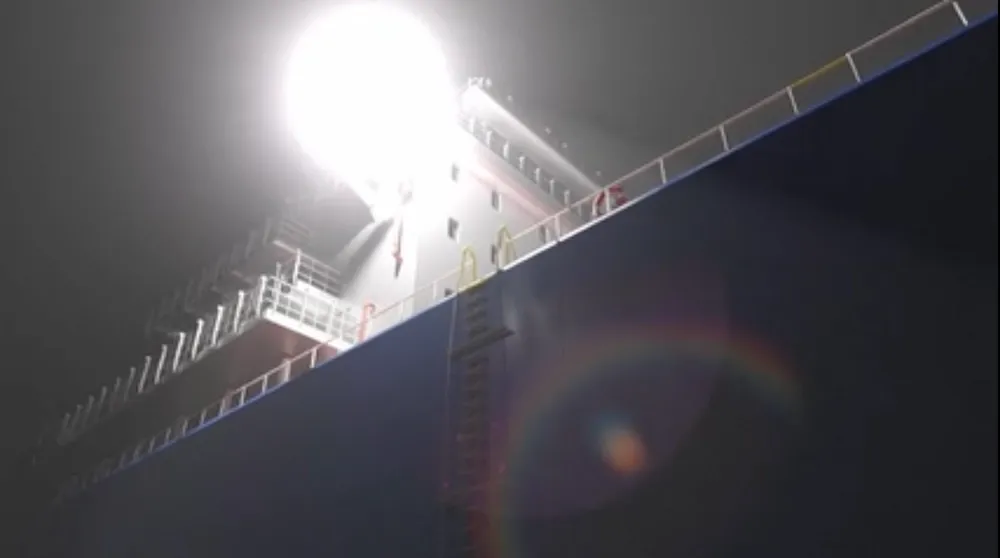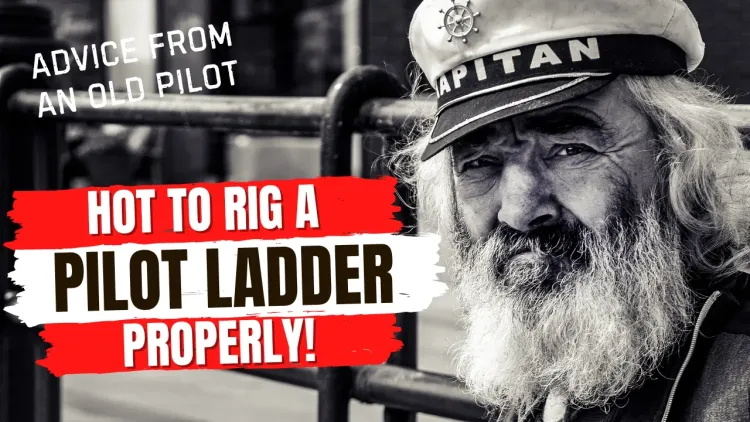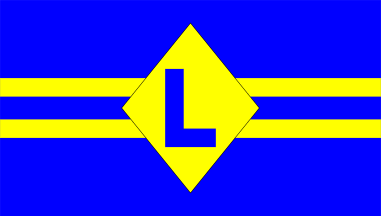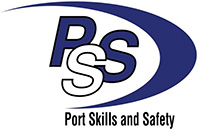How To Rig A Pilot Ladder Properly an A-Z Of Safety
The safe transfer of maritime pilots to and from vessels is a high-risk operation that demands attention to detail and adherence to the highest safety standards. As a maritime pilot with over 22 years of experience navigating the treacherous waters of pilot transfer, I can attest to the importance of properly rigged pilot ladders. In my time I have climbed over 8000 ladders, seen some horrors, sadly lost a colleague in early 2023 during pilot transfer and have also seen colleagues badly injured by dangerous pilot ladders.
In this article, I will share best practices and insights into the rigging of pilot ladders, drawing from industry regulations and personal expertise to help ensure the safety of my fellow mariners. I’m just going to cover pilot ladders alone here. I will also write future articles on combination ladders and side access doors.
Understanding the Importance of Pilot Ladders
Pilot ladders are the lifeline for pilots as they embark and disembark from vessels. These ladders must be rigged in a manner that guarantees stability, security, and ease of access. The consequences of improperly rigged ladders are grave and can lead to severe injuries or even fatalities. Therefore, it is imperative that we, as maritime professionals, rigorously follow the relevant regulations and guidance.
The advice contained within this article includes information from SOLAS Chapter 5 Regulation 23, IMO Resolution A1045(27) and ISO 799 Parts 1-3 as well as best practice and good seamanship.
Rigging Pilot Ladders: A Step-by-Step Guide
1. Training: The number one way to make sure you or your crews know how to rig a pilot ladder properly is by appropriate training. Fathom Safety’s Pilot Ladder Training is a computer based, 3D animated 5-chapter course covering every aspect and every boarding type. It complies fully with the requirements of ISO799.
2. Ensuring the Right Location: Although generally beyond the control of the crew, the pilot embarkation station should be positioned away from possible discharges and preferably within the mid-ship half-section to provide the most sheltered and stable environment for transfer. Any rubbing bands should have a 6m cutaway in them to allow for the safe approach of the pilot boat (ships less than 90m or with specialist roles can have a derogation by flag state/class). The positioning should be such that the pilot ladder can rest firmly against the ships side in this location.

3. Inspecting the pilot ladder: Prior to use (and post use) the ladder MUST be inspected by a responsible officer and this inspection formally recorded along with the details of the person conducting the inspection. This does not mean turning up on deck after the Bosun and AB’s have rigged the ladder and saying you have done a proper inspection. Remember if anything goes wrong every process will be analysed by experts, investigators and ultimately lawyers. Your sea career could be incredibly short if you cut corners on vital items of safety. The responsible officer should remain on deck to witness the entire process of securing and his confirmation that the ladder is properly inspected and rigged in accordance with the regulations (listed above) should be made in the deck logbook.
4. Securing the Ladder: The ladder must be secured to strong points on the deck, ensuring that it can bear the weight of the pilot without any risk of detachment or slippage. Deck strong points should be certified to a SWL of not less than 48kN (or 5t) and this SWL shall be painted onto the deck in the vicinity of the strong point.
5. There are two methods of securing the pilot ladder. If the ladder is being used at it’s full extent then it shall have the thimbles shackled to the deck with appropriately certified shackles the pin of which shall be moused or secured with a split pin. In the more likely scenario, the ladder will be secured at an intermediate length in which case the ladder shall be secured with two dedicated and appropriately tagged securing ropes with a breaking strain of not less than 48kN.


Do not use any old piece of deck store whammy or string for this purpose as when it breaks the accident investigator will be wanting your Certificate of Competency! The rope should be secured to the side ropes of the ladder by means of a rolling hitch (if you don’t know look it up it’s very simple) such that the weight is always borne by the side ropes and that the hitch does not slide up onto the step fixtures. The fixtures are not designed to be load bearing and could fail!
6. Height and Horizontal Steps: The lower end of the ladder should be at an appropriate height above the water as requested by the pilot, VTS or as indicated in port authority literature and the steps must be horizontal to facilitate easy access from the pilot boat. I cannot stress enough the importance of having a horizontal ladder. Trying to climb a wonky ladder is highly dangerous and if a ladder starts with an angle it only tends to get worse as the pilot climbs.
7. Manropes: ARE NOT NEEDED when a pilot is boarding. Manropes only serve a useful purpose when a pilot is disembarking and shall only be rigged should the pilot request them. Otherwise they can simply get in the way of the pilot and hinder his ability to climb safely.
8. Lighting and Safety Equipment: Adequate lighting should be provided at the point of embarkation and disembarkation but it is important you don’t blind the pilot as he climbs. Shining a powerful searchlight into the pilots retinas as he tries to find his next handhold will not make you popular. A lifebuoy with a self-igniting light and a heaving line should be readily available for immediate use.

9. Communication: The bridge should be in direct communication with the pilot boat and the responsible officer on deck. The responsible officer should position himself so that he can witness the entire operation and inform the bridge as the pilot boat approaches, is alongside, as the pilot is on the ladder, confirmation the pilot is safely aboard and when the pilot boat is clear and the vessel is free to manoeuvre.
10. Any bags should be transferred after the pilot is safely aboard via heaving line.
11. Finally remember chances are the person meeting the pilot is probably in his 20’s whereas the pilot is most likely in his 40s or 50s will possibly be wearing an extra 10kg of equipment and has just climbed a possibly 9m ladder. Running off like a greyhound to take him to the bridge won’t be popular. Unless he indicates otherwise give him a few seconds to catch his breath and offer to carry his bag!
Common Pitfalls and How to Avoid Them
Despite clear regulations, CHIRP Maritime continues to report numerous instances of poor seamanship in the rigging of pilot ladders. To avoid these pitfalls, crews must apply good seamanship and practical skills.
The number 1 issue is tripping lines! Tripping lines should be fastened at or above the bottom spreader and lead forward, to prevent entanglement with the pilot boat. This is the biggest issue we see. I used to work with an old pilot who carried a pocket knife and would delight in cutting any wrongly rigged tripping line. I’m sure the crew wished they’d not rigged it incorrectly as they struggled to heave the ladder back on board!
Click to read our full top 10 pilot ladder mistakes
The Future Of Pilot Ladder Regulation
While current regulations provide a framework for safety, there is always room for improvement. The maritime community must advocate for clearer, more straightforward rules that leave no room for misinterpretation. NCSR 10 will hopefully make strides forward in these areas and also ensure regular training in pilot ladders becomes mandatory.
Conclusion
The safe rigging of pilot ladders is not just a regulatory requirement; it is a fundamental responsibility that we owe to every individual who risks their life in the service of maritime pilotage. By rigorously applying the best practices outlined in this article, we can significantly minimize the dangers associated with pilot transfer operations. Your pilot ladder is the first thing your pilot sees, having a good quality, well rigged pilot ladder gets the whole operation of pilotage off to a positive start. There is nothing worse than having to spend the first few minutes onboard informing the master he is about to be reported to Port State Control for having a non-compliant pilot transfer arrangement.
For those interested in furthering their crew’s knowledge and skills in pilot ladder safety and transfer procedures, resources and training are available through organizations like Fathom Safety. All images used in this article are taken from Fathom Safety's comprehensive, 5 star rated training course that uses highquality 3D animation to deliver easy to understand pilot ladder training. Together, we can strive for a safer maritime industry, one ladder at a time.















